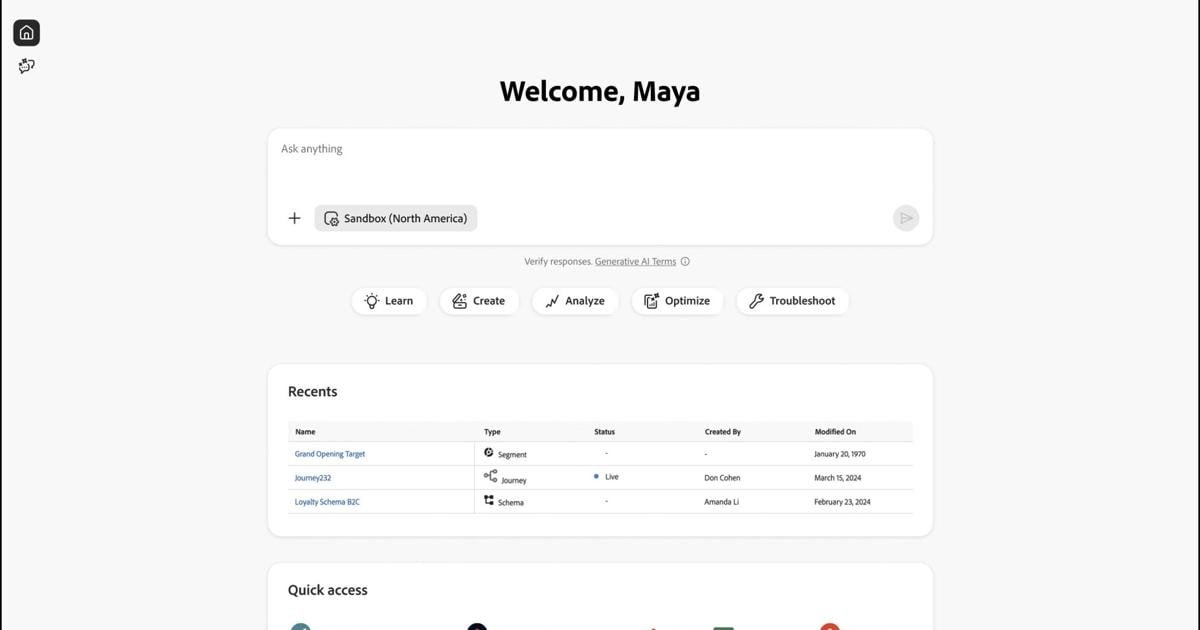SAN JOSE, Calif.–(BUSINESS WIRE)–Sep 10, 2025–
Today, Adobe (Nasdaq:ADBE) announced the general availability of AI agents that will reshape how businesses build, deliver and optimize customer experiences and marketing campaigns. Powered by the Adobe Experience Platform (AEP) Agent Orchestrator, Adobe is also creating an AI platform for businesses to manage and customize agents from Adobe and across third-party ecosystems—ensuring agents can understand context, plan multi-step actions, refine responses and more. AEP, used by many of the world’s leading businesses to connect real-time data across their organization, anchors Adobe’s offerings in a deep understanding of enterprise data, content and workflows. This provides the foundation for agents to take contextually relevant actions and deliver ROI.
This press release features multimedia. View the full release here: https://www.businesswire.com/news/home/20250910079322/en/
“Adobe has long helped businesses deliver engaging experiences to their customers, by turning digital data into actionable insights. We are now leveraging agentic AI to build specialized agents and embedding them into data, content and experience creation workflows,” said Anjul Bhambhri, senior vice president of engineering, Adobe Experience Cloud. “Our agentic AI innovations are elevating customer experience orchestration by reimagining processes, unlocking productivity for marketing teams and delivering personalized experiences at scale to drive growth.”
Over 70% of AEP customers are already using Adobe’s AI Assistant, which is the conversational interface that will enable teams to interact with agents across Adobe and third parties. Brands including The Hershey Company, Lenovo, Merkle, Wegmans Food Markets, Wilson Company and others have been working with Adobe’s agentic AI offerings to enhance capabilities within their organizations—and deliver impactful customer experiences.
Redefining Customer Experience Orchestration with AI agents
Adobe also announced the general availability of AEP Agent Orchestrator, including a reasoning engine where decision science and language models will enable dynamic and adaptive reasoning. This will ensure user intent can be interpreted from natural language prompts, to dynamically determine which agents are activated as part of an orchestrated plan. With AEP as the foundation, Agent Orchestrator will drive contextually relevant and goal-oriented automated actions, with support for refinement using a “human-in-the-loop” approach.
Out-of-the-box AI agents —which will be surfaced directly within category-leading Adobe enterprise applications such as Adobe Real-Time Customer Data Platform, Adobe Experience Manager, Adobe Journey Optimizer and Adobe Customer Journey Analytics—can be leveraged by businesses to enhance the skills of marketers and accelerate Customer Experience Orchestration (CXO). These AI agents include:
- Audience Agent will enable teams to quickly create, scale and optimize audiences that can be activated for personalization initiatives. High value audiences can be leveraged quickly through actionable recommendations and monitored closely to meet organizational goals and KPIs.
- Journey Agent in Journey Optimizer simplifies the creation and orchestration of customer journeys and campaigns across channels such as web, mobile, app, email and more. The agent will create journeys based on defined goals, optimize touchpoints based on aspects such as customer drop-off and uncover insights to fine-tune interactions.
- Experimentation Agent analyzes experimentation performance data, enabling teams to hypothesize new ideas for optimization efforts, analyze causal impact and identify predicted conversion or lift. It will be available in Journey Optimizer Experimentation Accelerator, for teams to easily turn experiments into AI-powered insights that drive growth.
- Data Insights Agent in Customer Journey Analytics (CJA) streamlines the process of deriving insights from signals across an organization, enabling any team to visualize, forecast and remediate customer experience initiatives. This agent is now available in CJA as well as across other Adobe enterprise applications.
- Site Optimization Agent delivers always-on support for teams to manage brand websites for high performance. The agent automatically detects and raises issues impacting customer engagement—such as broken back links or low performing pages—which can then be easily addressed via Adobe Sites Optimizer.
- Product Support Agent enhances the process of resolving issues for Adobe customers, leveraging a vast array of knowledge sources and organizational data to help users get the most value out of their enterprise applications. This now includes troubleshooting support—including case creation and tracking—directly in user workflows.
Unified experience for customizing and extending AI agents
Coming soon, Experience Platform Agent Composer provides a single interface for businesses to customize and configure AI agents based on brand guidelines, organizational policy controls and more. This will enable teams to fine-tune AI agent actions and shorten time-to-value. Additionally, new developer tools including an Agent SDK and Agent Registry will enable developers to build, extend and orchestrate agentic apps—expanding use cases into new industries and user personas.
As teams embrace agentic AI to augment daily work and drive better results, interoperability amongst AI agents in different ecosystems is critical. Agent Composer equips businesses with tools to drive multi-agent collaboration using the Agent2Agent protocol. This extends the value of agentic AI across more workflows, with customization capabilities that address specific needs. Adobe also announced new agentic AI partnerships with Cognizant, Google Cloud, Havas, Medallia, Omnicom, PwC and VML, enabling seamless execution of workflows across agents, as well customization across industries and use cases.
About Adobe
Adobe is changing the world through digital experiences. For more information, visit www.adobe.com.
© 2025 Adobe. All rights reserved. Adobe and the Adobe logo are either registered trademarks or trademarks of Adobe in the United States and/or other countries. All other trademarks are the property of their respective owners.
View source version on businesswire.com:https://www.businesswire.com/news/home/20250910079322/en/
CONTACT: Public relations contacts
Kevin Fu
Adobe
KEYWORD: UNITED STATES NORTH AMERICA CALIFORNIA
INDUSTRY KEYWORD: SOFTWARE PROFESSIONAL SERVICES HARDWARE CONSUMER ELECTRONICS APPS/APPLICATIONS TECHNOLOGY ARTIFICIAL INTELLIGENCE DIGITAL MARKETING DATA ANALYTICS MARKETING COMMUNICATIONS CONTENT MARKETING
SOURCE: Adobe
Copyright Business Wire 2025.
PUB: 09/10/2025 09:37 AM/DISC: 09/10/2025 09:36 AM



























